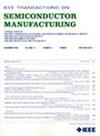提高硅通孔的可靠性:通过人工缺陷处理和退火减少铜突起
IF 2.3
3区 工程技术
Q2 ENGINEERING, ELECTRICAL & ELECTRONIC
引用次数: 0
摘要
硅通孔(TSV)是制造三维堆叠结构半导体封装的一项关键技术,它可以形成穿透硅晶片的孔洞,实现多个晶片的垂直互连。通常情况下,TSV 是通过在硅片上钻通孔并使用电镀铜工艺填充其内部而形成的。随后,在后端线 (BEOL) 过程中,晶片会暴露在高温环境中。然而,不适当的电镀铜条件会在 TSV 内形成空洞和接缝等缺陷,而 BEOL 工艺的高温则会诱发铜突起现象。这些缺陷和铜突起会降低 TSV 的可靠性。在本简介中,通过实验探索了 TSV 填充过程中可能出现的接缝缺陷,从而减轻了直接导致 TSV 可靠性下降的铜突起行为。随后采用退火工艺,根据铜晶粒的生长情况消除接缝缺陷。根据接缝缺陷的大小和退火温度分析了铜突起的高度。根据本文提出的工艺,确认无接缝缺陷和有接缝缺陷的 TSV 的铜突起高度分别为 1.531 和 1.289~\mu \text{m}$,提高了约 15.81%。本文章由计算机程序翻译,如有差异,请以英文原文为准。
Improving the Reliability of Through Silicon Vias: Reducing Copper Protrusion by Artificial Defect Manipulation and Annealing
Through silicon vias (TSVs) are a critical technology for manufacturing three-dimensional stacked structure of semiconductor packages by forming holes that penetrate silicon wafers and vertically interconnect multiple wafers. Typically, TSVs are created by drilling via holes in wafers and filling their interiors using copper electroplating processes. Subsequently, the wafers are exposed to high-temperature environments during the back-end-of-line (BEOL) process. However, improper copper electroplating conditions can form defects, such as voids and seams, within TSVs, while the high temperature of the BEOL process induces copper protrusion phenomena. These defects and copper protrusion degrade the reliability of TSV. In this brief, copper protrusion behavior, which is a direct cause of reliability degradation in TSVs, was mitigated by experimentally exploring the seam defects that can occur during the TSV filling process. Subsequent annealing processes were applied to remove the seam defects based on the copper-grain growth. The copper protrusion height was analyzed based on the size of the seam defects and annealing temperature. From the proposed process in this brief, the copper protrusion heights of TSVs without and with seam defects were confirmed to be 1.531 and
$1.289~\mu \text{m}$
, respectively, representing an improvement of approximately 15.81%.
求助全文
通过发布文献求助,成功后即可免费获取论文全文。
去求助
来源期刊

IEEE Transactions on Semiconductor Manufacturing
工程技术-工程:电子与电气
CiteScore
5.20
自引率
11.10%
发文量
101
审稿时长
3.3 months
期刊介绍:
The IEEE Transactions on Semiconductor Manufacturing addresses the challenging problems of manufacturing complex microelectronic components, especially very large scale integrated circuits (VLSI). Manufacturing these products requires precision micropatterning, precise control of materials properties, ultraclean work environments, and complex interactions of chemical, physical, electrical and mechanical processes.
 求助内容:
求助内容: 应助结果提醒方式:
应助结果提醒方式:


